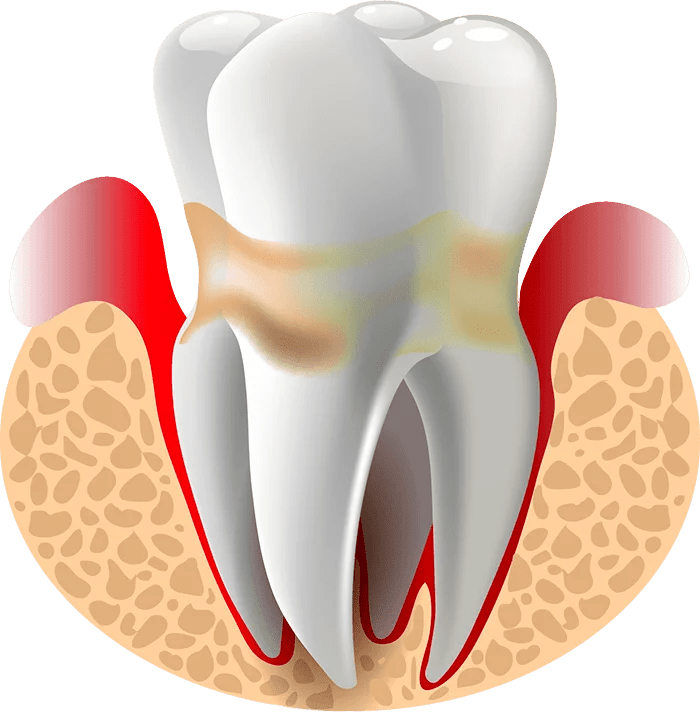- 1720 Milwaukee Ave, Glenview IL - 60025
- (224) 567 8505
There are two types of gum disease. Gingivitis, which is familiar to people and is more common, is a condition that causes gums to become swollen, red, and bleed easily. Gingivitis is most commonly caused by inadequate brushing and flossing.

However, left untreated, Gingivitis can progress to Periodontitis. This is where plaque spreads below the gum line. Bacteria will collect there and release toxins. The body responds to the constant presence of toxins with chronic inflammation. This inflammation breaks down the tissue under the gum line, creating “pockets,” which can then become infected. Over time, both gum tissue and bone are damaged or destroyed, which can eventually result in tooth loss.
Gingivitis and Periodontitis are often not painful at all. People will often ignore the inflammation or other symptoms until they come into the office wondering why they have a loose tooth. This is why it is very important to educate patients about gum disease and why dentists will check the health and condition of the gums as well as the teeth at each checkup visit.
Untreated gum disease can result in the loss of teeth, but it doesn't just stop there. Gum disease can have major impacts on other body systems and has been tied to other serious health issues and can make body areasconditions worse. Other areas of the body directly affected by gum disease include the heart, lungs and respiratory system, reproductive system and pregnancy for women, digestive system, and more. Get more information about how Gum Disease affects the whole body.
The most commodure used to trPlanningdisease is called Scaling & Root planning (SRP). This is typically done on one quadrant, or quarter, of the mouth, at a time.
First, your dentist or dental hygienist will numb the area to be treated. Then your dentist or hygienist will perform a deep cleaning (scaling) to remove calculus (buildup) underneath the gum line, all the way to the roots of the teeth. This also removes the bacteria that are causing the infection. Your dentist may also smooth down areas of the root (planing) to prevent bacteria from finding places to collect in the future.
Gum disease can be reversed in most cases when proper care is taken. Plaque control consisting of professional cleanings at least twice a year accompanied by daily brushing and flossing is absolutely necessary. Brushing eliminates plaque from the surfaces of the teeth that can be reached, while flossing removes food particles and plaque from in between the teeth and under the gum line.
The cost of treating periodontal disease will vary depending upon a variety of factors, including the severity of the condition, the area(s) needing treatment, the type of treatment provided, and the amount of follow-up needed to ensure the treatment is successful. Prior to your procedure, your dentist will review what treatment is needed, and our staff will provide you with information about any fees associated with the procedure, as well as options available to help make sure you receive the dental care you need in a way that fits into your budget.
If you have dental insurance, your coverage may include treatment for periodontal disease. It is important to stay up to date with your insurance coverage. Our staff is happy to review your coverage with you to ensure you are maximizing your insurance benefits while minimizing any out-of-pocket expenses.
Early symptoms of Gingivitis include red, swollen gums, which may present in one specific area of the mouth. Your gums may bleed infrequently, or they may often bleed when you brush or floss. Symptoms of more advanced gum disease can include bad breath that does not go away after brushing or rinsing, sore, bleeding gums, or loose teeth.
Your teeth may look longer because your gums have receded. If you have a partial, it may fit differently, or your teeth may not bite together normally. If you experience these symptoms, it is best to see your dentist as soon as possible.
At Glance dental office, we offer evaluation and treatment for periodontal disease as a part of our comprehensive oral health services.
Many patients may experience some degree of sensitivity in the treated area, but this should go away after a short period of time. Your dentist will review post-procedure care instructions, which include avoiding smoking and avoiding certain foods and beverages for a period of time.
After about 4 to 6 weeks, you should return to the office for a follow-up visit to assess how the gums are healing, review at-home hygiene habits and techniques, and determine the next steps if additional treatment is necessary.
Patients who are curing gum disease will often need to return for more cleaning and "periodontal maintenance" visits, usually every 3 to 4 months for a period of time to ensure that the bacteria and calculus are not collecting below the gum line and to help the healing process.
How can I prevent gum disease?
The majority of gum disease cases can be prevented by good oral hygiene at home and regular checkups every six months with your dental professional. A healthy oral hygiene routine consists of brushing for two minutes twice a day with a soft-bristled brush and toothpaste and flossing at least once per day. If you have been treated for gum disease in the past, your dentist may recommend a maintenance program requiring more frequent checkups and cleanings for a limited amount of time.
Catching issues such as gum disease as early as possible will help keep your body in prime condition to heal itself. With that in mind, it is also important to take good care of your whole body. A healthy diet, exercise, and regular checkups with your general doctor will help you to ensure your mouth truly is the reflection of your good health.

Monday 9AM – 5PM
Tuesday 9AM – 5PM
Wednesday 9AM – 5PM
Thursday 9AM – 5PM (Consultation Only)
Friday 9AM – 5PM
Saturday Closed
Sunday Closed